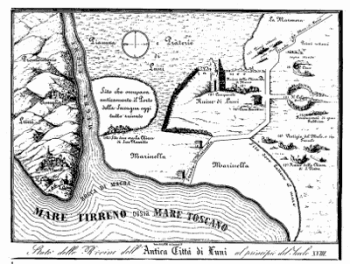The small town of Luni is a delightful destination for those who love archaeology, history and nature. It gives name to the ancient region of Lunigiana, which spanned between eastern Liguria and northern Tuscany. Luni, which is a 50-minute drive from Portovenere, is surrounded by the valley called Val di Magra in the Montemarcello Magra Park, which extends from inland Liguria up to the Gulf of Poets. Points of interest include remains of the Roman Amphitheater (1st century AD) and the Archaeological Museum.
Some History

There are different theories regarding the origins of the town’s name. Some believe that it was named after the ancient goddess Lunae of the local, primitive populations. Others claim that the name was inspired by the shape of its territory and harbor, which resembled a crescent moon (luna).
Luni became a Roman colony in 177 B.C. This territory had both strategic and economic importance. In fact, the particular position of the town allowed the Romans to control both Ligurian and Etruscan lands. The Apuan Alps provided them with a rich resource – marble – which was carried to Rome and around Italy to create statues and other furnishings. Apart from the white marble quarries, the town was also an important agricultural colony, producing great cheese and wines.
In the 5th Century, Luni regained importance and visibility when it was chosen as the seat of a Diocese, which not only had religious power but was the main political and administrative organ of the city until 1204, when the bishops’ headquarters were moved to Sarzana. In the following centuries, Luni would be captured by Goths, Byzantines, Lombards, the Spanish taifa of Dénia, and sacked by pirates. This tormented history and the spread of malaria during the Middle Ages, contributed to the steep decline of the town. In 1058 the whole population moved to Sarzana, while other refugees founded Ortonovo.
A slow repopulation process started from the 1440s, when beautiful archaeologic remains were identified in Luni, leading a depredation of the Roman ruins of Luni.
Archaeological Sites
Proper archaeological excavations started in the 1950s: many of the treasures brought to light are now housed in the adjacent museum (Museo Archeologico Nazionale di Luni). Archeological evidence suggests that the Roman forum had been abandoned as a public space by the end of the sixth century, its buildings fell to ruin or were demolished and decorative marbles removed.

The main attraction is Luni’s elliptical amphitheater. It was able to accommodate up to seven thousand people, who would flock here to watch performances involving animals and gladiatorial games.
The first documents related to the amphitheater date back to the year 1185; but in 1442 Ciriaco d’Ancona already depicted it as already in decay, largely collapsed, its mighty marble columns broken and its statues shattered. Some of its remains are part of the Museum of La Spezia’s permanent collection.
Other impressive constructions visible to this day are the Great Temple, one of Luni’s most ancient sights, and the Forum.
If you would like to visit the ruins of Luni, contact the Museum for information on opening times and admissions. Visit www.luni.beniculturali.it
Sources: